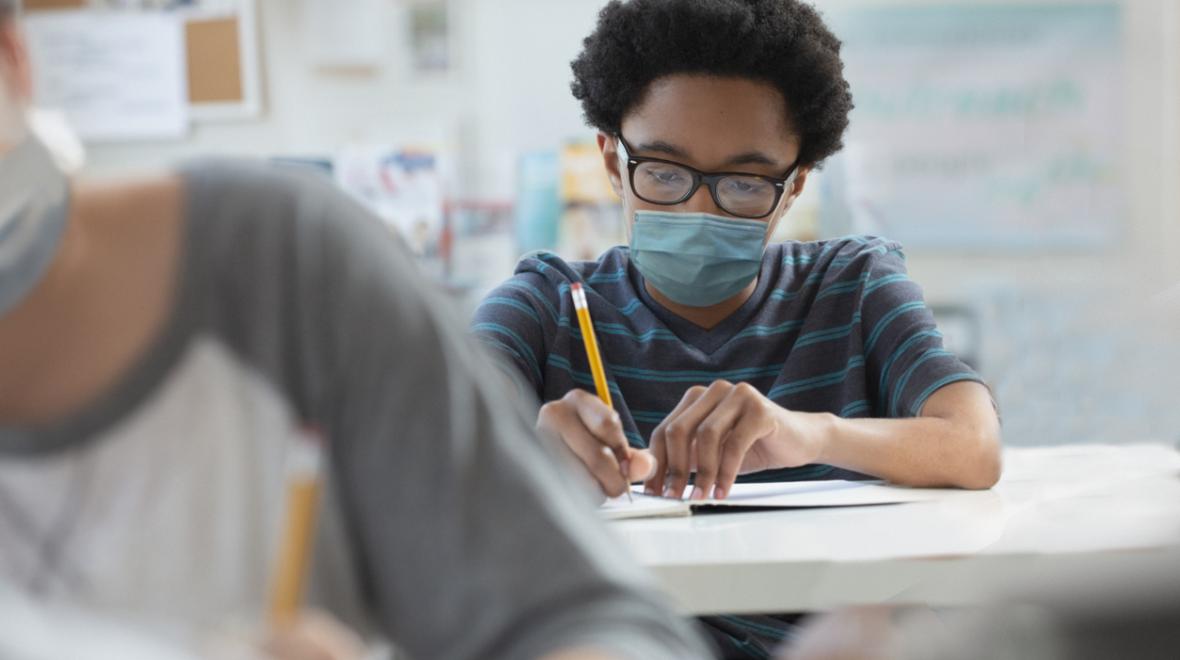
Scott Hampton, manager of K–12 Education Services and father of three, sat down with Seattle Children's On the Pulse to share advice to support families in the community as they settle back into in-person learning in this new school year.
This excerpted post was originally published on the Seattle Children's On the Pulse blog.

After last year, many parents are concerned that their children didn’t learn as much as they would have in a normal school year. What are you noticing so far this year, and what do you want families to know?
As their children head back to school, many parents are concerned that their child may have fallen behind their classmates academically. I really want to encourage families to remember — we’re all in this together. You are not alone. Largely, the disrupted school year was a shared experience with individual variance. Our schools and teachers are starting the academic year assessing for gaps our students have and are ready to get creative in bringing everyone up to their full potential.
What we’re seeing is that indeed there was learning loss and that some students were more affected than others. While this is discouraging, it’s helpful to know that learning is not linear — it truly comes in leaps and bounds. So, while some students may have struggled last year, we’re anticipating periods of robust growth that will narrow those achievement gaps.
We’re also encouraging families and schools to take a holistic approach when assessing last year’s learning. Many students learned more about their family values, had the opportunity to contribute to chores in their homes and communities, engaged in political discourse and examined the impacts of racism and discrimination through new events and lenses. These are extremely valuable experiences that help our kids grow in their sense of self, and they will absolutely contribute to school readiness this fall.
What does successful communication between families and their child’s school team look like?
Communication between school and home can be really helpful in staying aligned with your child’s teachers throughout the changing landscape of the academic school year. I like to remind both teachers and parents that communication is most effective when it flows in both directions. While it’s important for teachers to send regular communication home about what’s happening in the classroom, it’s also important for families to acknowledge those communication attempts and even initiate periodically to help your teacher know what’s going on with your child at home.
As a teacher, it’s helpful when I have a heads up about things like “My child was up until 3 a.m. last night” or “My child’s grandmother passed away” or “We just got a new puppy” or “We changed my child’s medication.” These types of details can help ensure that I set the right level of expectations for my students. Oftentimes a quick email or phone call can go a long way toward creating an open dialog between you and your child’s school team.
When it comes to communication about learning concerns, whether new or pre-existing, frequent and specific communication is important. Oftentimes context matters, so what we see at school and what we see at home from our children is not always the same. By comparing notes, teachers and parents can determine if there’s a consistent concern and what strategies are working best.
I am also reminding parents with students receiving special education services that their child may qualify for recovery services, which are designed specifically to address the impact of school closures during the COVID-19 pandemic. The need for recovery services should be evaluated against their previous Individualized Educational Plan (IEP). Ask your child’s IEP manager to meet and discuss the need for these services.
How can families set their children up for success with everything from getting out the door on time to turning homework in by the due date?
The phrase “clear is kind” comes to mind for me as we help our kids know what to expect about going back to school. Taking some intentional time to talk to your child about your family expectations on topics such as routines, homework and screen time, and then giving opportunity for practice can help bring clear expectations. I often recommend additional systems such as checklists, sequence photographs, reminder alarms on smartphones and positive reinforcement when things are going well.
It’s also important to remember that all behavior is communication, so when your child is not meeting those expectations, try to understand what they might be trying to tell you and respond accordingly. Are they wanting your attention? Do they lack the skill needed to complete the request? Are they feeling overwhelmed?
In terms of setting expectations for school, remember that the school will take the lead on this, and you as a family get to reinforce those messages. Your teachers are looking at the first four to six weeks of school as an opportunity to build routines and expectations in addition to physical and emotional safety. Asking your school for information about things like masking, lunchtimes, shared materials policy and homework, allows you to know what messages your child is receiving and will help you reinforce them through your conversations at home.
Putting your “parent hat” on, what are your best tips for setting up systems to reduce stress related to managing school?
Building routines can help your family spend less time thinking about what needs to be done and ensure tasks are completed reliably. In our family, our kids pack their lunches as part of their chores the night before. This routine helps make our school-day mornings less hectic. Likewise, our afterschool routine is sequenced as follows: Empty lunch box, put backpack away, eat a snack, unstructured play for 45 minutes and then homework. This helps our kids transition from school by meeting basic needs before putting demands back on them.
I also find that the most helpful stress reducers are strategies that fit your particular style. We found we were getting overwhelmed by the number of emails sent by our three kids’ teachers and school, so my wife set up a Gmail account just for school communication, and we put that email on all school-related forms. We also found that the volume of projects and papers the kids brought home from school to show us was extremely high. To counteract that volume, as the kids show us their work, we sort it into keep, recycle and “hang on the fridge” piles when we get them.
Finally, I try to remember that all systems are moving toward chaos or atrophy. So, usually, our systems and routines start out strong and eventually fade out. Rather than view the broken system as a failure, we take a beat to see if there’s still a problem that needs solving, and if so, design or refine a system to address it.
What is your go-to advice for families who ask how to support their child’s social-emotional learning?
One of my colleagues recently imagined a world where “people listen deeply and unrushed to one another.” This is what our kids need from us. We will absolutely promote social-emotional learning if we learn to listen and notice the ways they are trying to connect with us — when they look over our shoulder while we pay bills, or interrupt our cooking when we’re trying to focus, or they start chatting from the backseat of the car. These moments are precious, and it’s their way of connecting with us. When you can, turn your attention to them, stay curious about what they’re saying and reflect back on what you’re hearing.
I think it’s really important to remember that our kids do not need us to solve all of their problems. We have decades of living to draw on; they are daily having experiences for the first time and working to make sense of the world through those experiences. Our job as parents is to help them navigate that meaning-making through asking good questions, helping them take multiple perspectives and validating their feelings.
Seattle Children’s Education Department provides free services for students who will be in the hospital for at least one week. The teachers are certified by the state of Washington in both general and special education. They’re experts at supporting kids and their families when children and teens are suddenly out of school and as they transition back into school after an extended absence.











